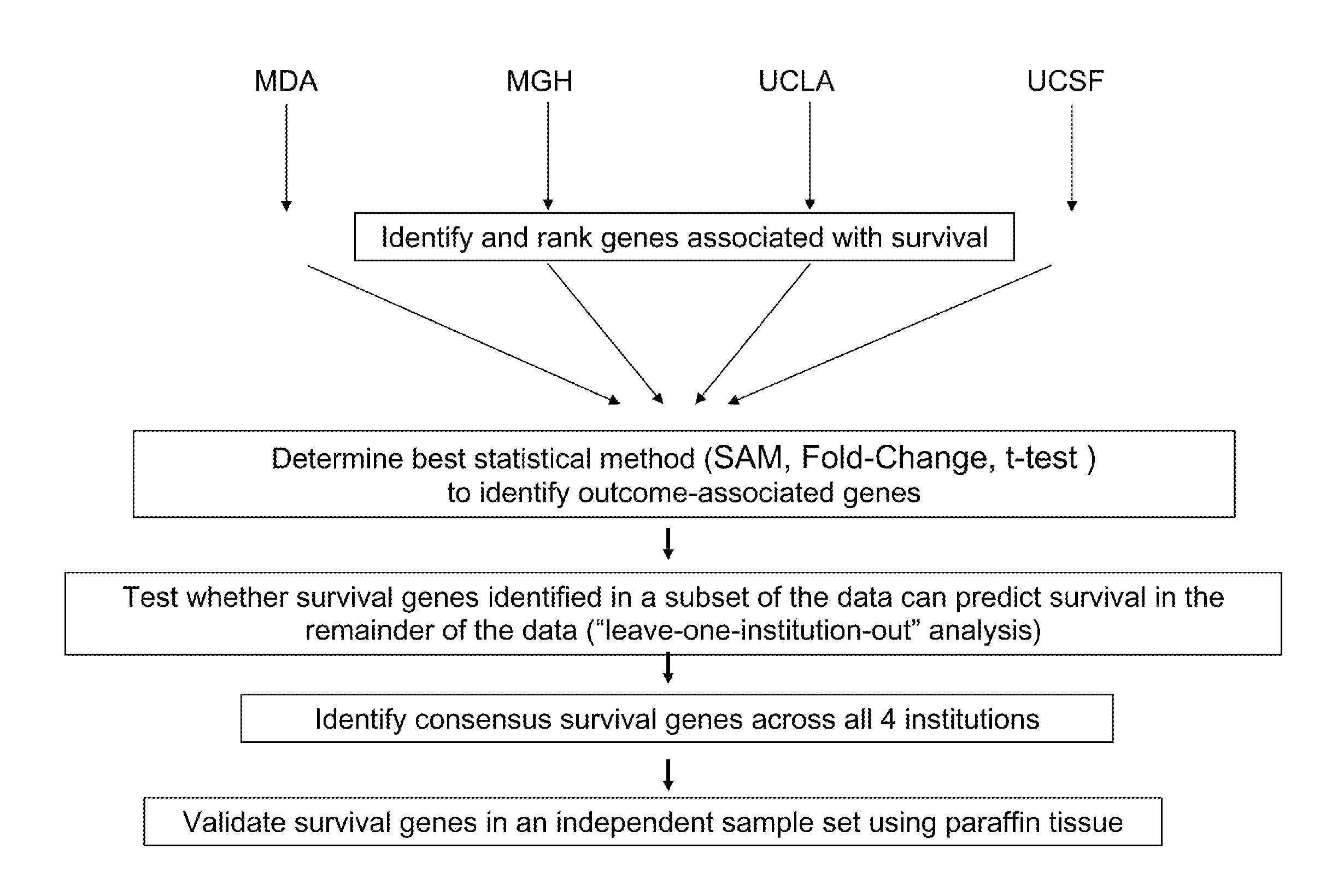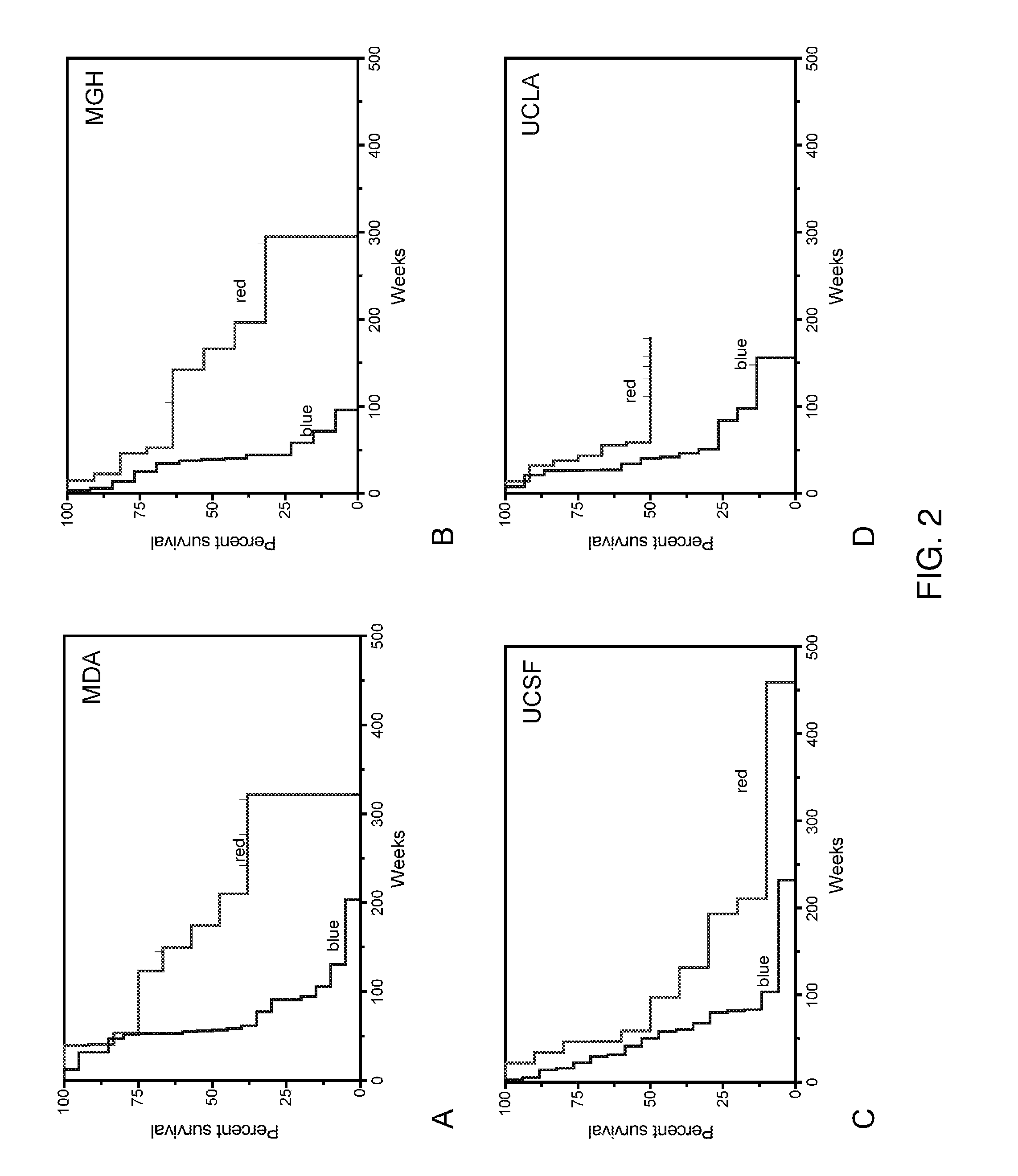Multigene assay to predict outcome in an individual with glioblastoma
- Summary
- Abstract
- Description
- Claims
- Application Information
AI Technical Summary
Benefits of technology
Problems solved by technology
Method used
Image
Examples
example 1
Exemplary Materials and Methods
[0165]Exemplary materials and methods may be utilized as follows.
Gene Expression Array Datasets
[0166]The meta-analysis was performed using 4 previously published GBM microarray datasets (Nigro et al., 2005; Phillips et al., 2006; Freije et al., 2004; Nutt et al., 2003). Only World Health Organization-defined GBMs were included. The platform for all 4 datasets was Affymetrix-based and used 2 different chip types: U95Av2 and U133A. Data between these 2 chips were merged by mapping available probe sequence data with 2 databases (Pruitt et al., 2003; Imanishi et al., 2004).
Identification of Gene Expression Profiles Associated With Survival
[0167]Cases were dichotomized into typical (2 years) survival groups (TS versus LTS, respectively). Several statistical approaches were investigated to identify genes with the highest association with survival including fold-change (ratio of mean expression between TS and LTS) and Significance Analysis of Microarrays (SAM...
example 2
Statistical Method and Concordance of Survival Association Across Institutions
[0185]FIG. 1 shows the overall approach utilized for the identification of robust survival-associated genes in GBM. It is not well established which test statistic is optimal to identifying genes significantly associated with patient outcome from microarray data for the purpose of determining consensus genes across independent datasets (Shi et al., 2006). It was thus investigated whether fold-change (the ratio of the means in gene expression measurements between TS and LTS) or SAM performed better in the dataset for identifying common survival-associated genes across multiple institutions. Consistent with recent results from the Microarray Quality Control (MAQC) Project (Shi et al., 2006), the analyses demonstrated that the ranking of genes by degree of fold-change between TS and LTS was much more stable across independent datasets than if genes were ranked by a 2-class SAM analysis (FIG. 5). Fold-change w...
example 3
Gene Expression Profiles Predict Survival in Independent Samples of GBM
[0186]It was tested whether gene expression profiles from one set of GBM tumor samples could predict survival in an independent dataset using a “leave-one-institution-out” approach to cross validation. In each round of the analysis, 3 out of the 4 institutions were utilized to form a training set to identify the top genes associated with survival. The genes were ranked by fold-change difference of TS versus LTS and the top 200 were selected. The performance of this 200-gene profile was then tested for outcome prediction using K-means clustering (Stupp et al., 2005) in the remaining test set (which was not used to build the model). The 2 groups defined by the K-means clustering on the test set were then compared for patient outcome. This procedure was repeated for all (n=4) possible combinations of the datasets. The results (FIG. 2) demonstrated that the survival-associated gene expression profile from the trainin...
PUM
| Property | Measurement | Unit |
|---|---|---|
| Length | aaaaa | aaaaa |
| Length | aaaaa | aaaaa |
| Therapeutic | aaaaa | aaaaa |
Abstract
Description
Claims
Application Information
 Login to View More
Login to View More - R&D
- Intellectual Property
- Life Sciences
- Materials
- Tech Scout
- Unparalleled Data Quality
- Higher Quality Content
- 60% Fewer Hallucinations
Browse by: Latest US Patents, China's latest patents, Technical Efficacy Thesaurus, Application Domain, Technology Topic, Popular Technical Reports.
© 2025 PatSnap. All rights reserved.Legal|Privacy policy|Modern Slavery Act Transparency Statement|Sitemap|About US| Contact US: help@patsnap.com



